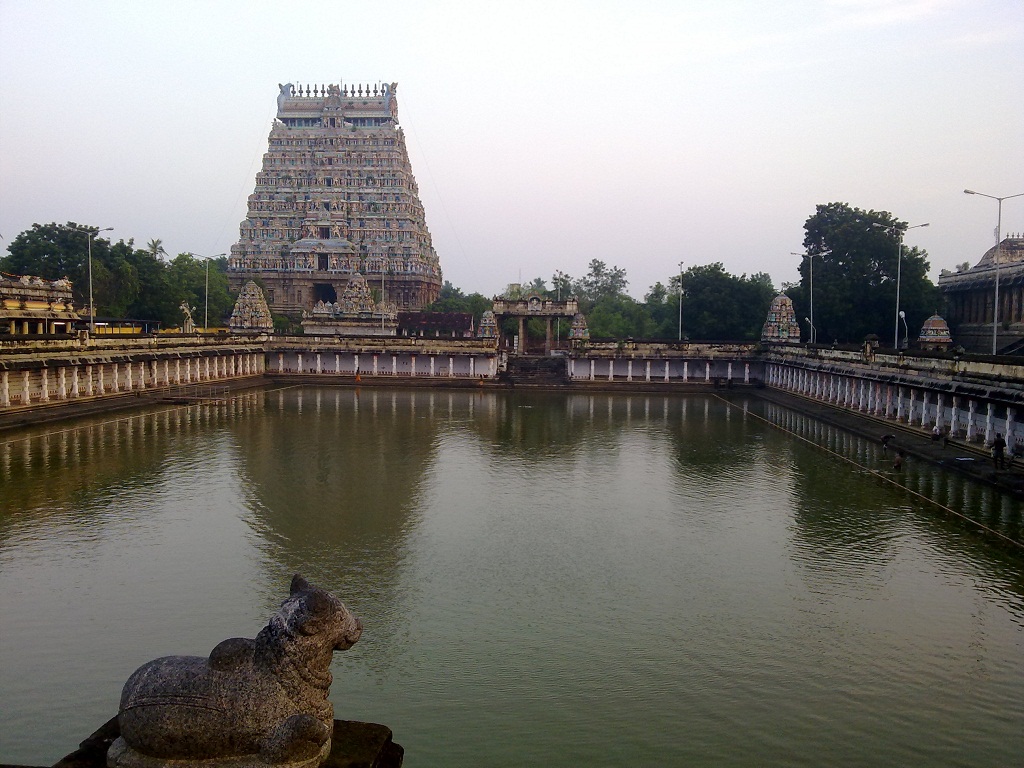The temple is facing the Bay of Bengal. All the planets in the Navagraha Mandap are facing the Lord-west. Lord Muruga graces with His consorts Valli and Deivanai in the prakara in a standing form. The peacock vehicle is absent in the shrine.
There are two Mothers Durga in the Prakara with demon Mahisha not seen under one Durga. There are two Chandikeswaras. River Cauvery enters the sea just near this place, hence the place is named Kaviri Puhum Pattinam. The present name of the place is Poompuhar.
There lived in this region a Shiva devotee couple Sivanesar and Gnanakamalambikai. They were blessed with a son named Tiruvenkadar. He was a marine trader. At 16, Tiruvenkadar married one Sivakalai but had no issues though years passed by.
To grace them, Lord Shiva was born to Siva Sarmar and Suseelai, a poor couple. The child was named Marudavanar. Lord Shiva appeared in their dream and advised them to give Marudavanar to Sivanesar in adoption.
Marudavanar, now the adopted son of Tiruvenkadar continued the marine trade of the family. Returning from his business travel one day, Marudavanar gave a box to the mother and left out. Tiruvenkadar
anxiously opened the box to see the wealth brought by the son but was
shocked to see the box containing a dung cake made with husk.
Throwing it in anger he found written on the cake,even a broken needle would not accompany the soul during the last journey. Tiruvenkadar learnt the truth and renounced his family life at once. He prayed to Lord Shiva to bless him with salvation. Lord appeared before him and assured that his wish would be granted at an appropriate time.
Festival:
Vaikasi Visakam in May-June and Aadi Pattinathar Vizha in July-August are the festivals observed in the temple.
Opening time:
The temple is open from 6.30 a.m. to 12.00 a.m. and from 4.30 p.m. to 7.30 p.m.
This is the birth place of saint Pattinathar. Lord Shiva is a swayambumurthy in the temple.
This is one of the 2 Shivastalams in the ancient Chola seashore capital of Poompuhaar,
a popular tourist destination, the other one being Tiruchaaikkadu.
Pallavaneeswaram is the 10th in the series of Tevara Stalangal on the
northern banks of the river Kaveri in the Chola region of Tamilnadu.
This is a small temple with a 5
tiered Rajagopuram and a single prakaram. A Pallava king's association with the
temple lends the name Pallavaneswaram.
Pattinathaar believed to be an incarnation of
Kubera is closely associated with Pallavaneeswaram and this association is commemorated
during the annual Aadi festival.There is also a separate shrine for Pattinathaar here.
There are also shrines to Surya, Chandra, Saneeswara, Bhairavar and Nataraja.
There is also a separate shrine to Sambaapathi Amman, which is believed to have been
worshipped by Madhavi and Manimekalai of the Sangam epics.
There is also an image of
Subramaniar, said to have been recovered from the ocean. It is believed locally that this
image is that of Subramaniar at Tiruchendur, which is said to have been carried away by
Dutch sailors in 1648. Interestingly both Pallavaneeswaram and Tiruchaaikaadu
bear similar legends associated with Indra, Sambaapathi Amman and Subramanyar.
Do's:
- Do pray your Ishta Devata before pilgrimage to Temple.
- Do contact Temple Devasthanam information centre for enquiry, temple information and for Pooja details etc.
- Do reserve your travel and accommodation at Temple well in advance.
- Do bath and wear clean clothes before you enter the temple.
- Do concentrate on God and Goddess inside the temple.
- Do maintain silence and recite Om Namahsivaya or your Istamantram to yourself inside the temple.
- Do observe ancient custom and traditions while in Temple.
- Do respect religious sentiments at Temple.
- Do deposit your offerings in the hundi only.
Don't s:
- Do not come to Temple for any purpose other than worshipping of God and Goddess.
- Do not smoke at Temple.Do not consume alcoholic drinks at Temple.
- Do not eat non-vegetarian food in the Kshetram.
- Do not approach mediators for quick Darshanam. It may cause inconvenient to others.
- Do not carry any weapon inside the temple.
- Do not wear any head guards like helmets, caps, turbans and hats inside the temple premises.
- Do not perform Sastanga Pranama inside the Sanctum Sanctorum.
- Do not take much time while performing Sparsa Darshanam to God in Garbhagriha.
- Do not buy spurious prasadams from street vendors.
- Do not encourage beggars at Temple.
- Do not spit or create nuisance in the premises of the temple.
